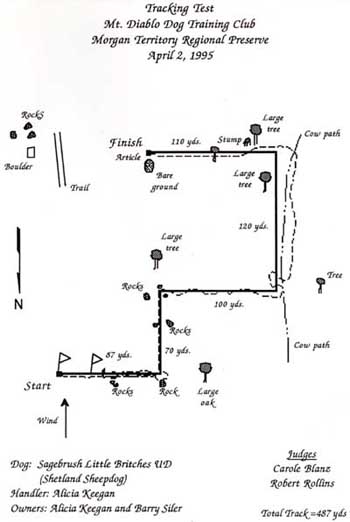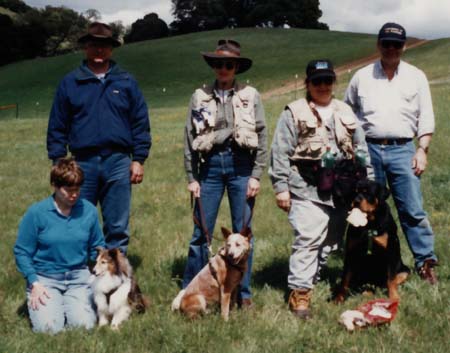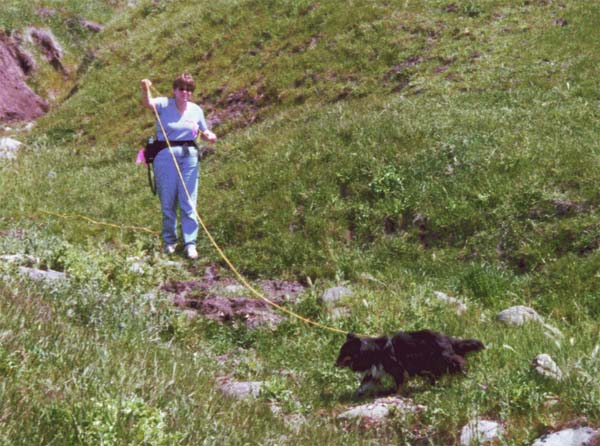|
|
 Reg
Where performance counts!
|
|
|
|
Tracking is a sport in which a dog
follows the scent of a person who has earlier walked through the
area. The dog must find and indicate various articles that the
person has dropped. The track is laid out in patterns of
straight lines and corners, not because the dog would have trouble
following a meandering walker, but because the judges must be
certain where the track is located. The track is thirty
minutes to
two hours old
for the Tracking Dog (TD) test, and three to five hours old for the
Tracking Dog Excellent (TDX) and Variable Surface Tracking (VST) Tests.
When most people think of
tracking, they think of bloodhounds or German shepherds, not of
Shelties. The community of tracking enthusiasts is a small
one, and that of Sheltie tracking enthusiasts is tiny. But
Shelties are just as capable of tracking as any other breed, and do
very well in tracking tests.
|
|
The first dog I trained to track was Ch. Sea Isle
Clancey of Sagebrush, UD. Clancey was a great tracker, but I
was mostly training by myself. No one was available to teach
me about reading and handling a tracking dog. As a result of
my ignorance, she never earned her TD. But she was the Sheltie
whose photos illustrate tracking for the book,
Sheltie Talk, with a much younger me handling her.
We took the pictures in Laramie, Wyoming, in about 1975, at the
request of author, Barbara Rieseberg.
|
|
This chart of Britches' successful TD track shows the tracklayer's route as a solid line
and the dog's path as a dotted line.
A tracking career for Britches
|
The first of my Shelties to earn a tracking title was Sagebrush Little Britches, UD TDX.
Britches was an indifferent obedience dog, but an excellent tracker. We started tracking when she was nine
years old, and she earned her TD at age eleven. She then went on to her TDX at age 12, on a very difficult
track that took her an hour to complete.
Britches was a distractable dog,
but very reliable when on the scent. She once tracked right
under the nose of a curious horse, without giving any indication
that she realized the horse was there. She tended to follow
the edge of the scent, a habit called "fringing", which makes it
harder to interpret the dog's actions, but she never missed an
article on that account.
|
Britches is pictured above the day she earned her TDX, only the 28th Sheltie to earn that
title. |
|
Raven was my third tracking dog.
She was a challenge to train, because at first she was afraid of the
glove! We finally got her to follow a track with the aid of
hard boiled egg, which is very messy to handle. She proved to
be an extremely reliable tracker, although I never knew until I got
to the start flag whether she would track that day or not.
Her successful TDX track was
memorable because of the small rattlesnake basking in the sun on the
downed tree trunk that was one of her obstacles. We had to
detour around the snake, with me carrying her.
Here, she searches for the scent in a muddy creek
bed.
Story of Raven's TDX Track
|
|
|
| CT Sagebrush Molly Brown, UD HS AX
OAJ HTD-IIs HRD-IIIs VCD2 was the first Sheltie in the country to
earn the AKC Champion Tracker title. She started tracking at
the age of eight, earned her TD at nine and her VST title at age
ten. Six months later, she passed her TDX test to become the
first Champion Tracker Sheltie.
|
|
| The dogs who were started
tracking after Molly all learned variable surface tracking as
puppies. Thus they learn from the very beginning that a
track can be followed on hard surfaces. Ceili, who earned
her TD in February 2007, worked out a transition from
mowed lawn to asphalt pavement at a 2005 advanced tracking
workshop.
CH-TD: the Second Generation
|
Ah, Dustin! Tracking wasn't
his first love–he much prefered agility and sheep herding.
Still he had a good nose, and was a very capable tracking dog.
He failed his first TD test because he decided,
only 30 or 40 yards from the end of the track, that there were
far more interesting things to do than wade through the tall
grass following a scent. He passed on a windy rainy day on
his second try.
When we started advanced tracking, he made it
quite clear that non-vegetated surfaces like asphalt and
concrete were much preferable to tall weedy grass in his face.
So, like Molly, he earned his VST title without having first earned a TDX. He passed in November 2015 at the University of
New Mexico in Albuquerque, where the non-vegetated surfaces
constituted a large majority of his track. He was the first
Champion Sheltie to earn a VST title.
It then took him six tries to earn his TDX and
Champion Tracker titles. He passed on a cloudy day at
Eagle Island State Park in the Boise, ID area to become the
seventh Sheltie and first breed champion Sheltie to earn the CT
title.
|
|
| |
Dustin and I are pictured with judges and tracklayer the day he earned
his TDX on November 20, 2016. He was very proud of himself, and shamelessly begged for his
share of my pulled pork sandwich.
|
|
|
| Ginny started her tracking training in 2020, when dog events were all cancelled and
the world shut down because of the COVID pandemic. She earned her TD title on March 12, 2023. Here she works a training track in December 2020.
Tracking With Ginny
|
|
 Reg
Reg 

